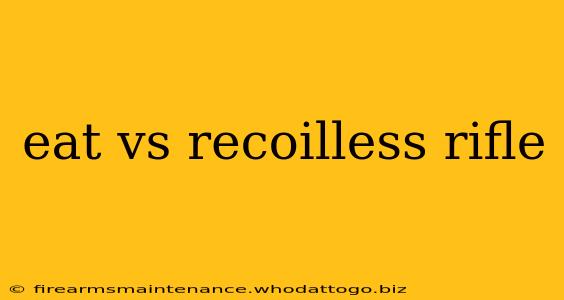The title might seem absurd, but comparing "eat" and a "recoilless rifle" offers a surprisingly insightful look at contrasting forces and unexpected consequences. While seemingly disparate, both involve a transfer of energy, albeit on vastly different scales and with drastically different outcomes. Let's delve into this unconventional comparison.
The Act of Eating: A Gentle Explosion
At its core, eating is a controlled form of energy transfer. We consume food – packed with potential energy in the form of carbohydrates, fats, and proteins – and our bodies process this energy through a series of complex biochemical reactions. This process, though seemingly gentle, is fundamentally an "explosion" on a microscopic level. The breakdown of food molecules releases energy, powering our cells and fueling our bodies' functions. This energy is used for everything from basic bodily functions to physical activity. It's a finely tuned system, designed for sustainability and growth.
Key Characteristics of "Eating":
- Gradual Energy Release: Energy is released slowly and steadily, allowing for efficient use and minimal waste.
- Controlled Process: The body tightly regulates the energy release through complex metabolic pathways.
- Positive Feedback Loop: Provides sustenance and fuels the body's ongoing processes.
- Essential for Survival: A fundamental requirement for maintaining life.
The Recoilless Rifle: Uncontrolled Energy Unleashed
In stark contrast, a recoilless rifle represents a dramatic and uncontrolled release of energy. It functions by expelling propellant gases both forward (to propel the projectile) and backward (to counteract recoil). This design minimizes the backward force felt by the shooter, but the overall energy released is significant. The explosion propels a projectile at high velocity, capable of inflicting considerable damage.
Key Characteristics of a Recoilless Rifle:
- Instantaneous Energy Release: A rapid, powerful burst of energy.
- Uncontrolled Process: The energy release is designed to be forceful and destructive.
- Negative Feedback Loop (Potentially): While designed to minimize recoil, the impact of the projectile can have devastating consequences.
- Destructive Potential: Primarily used for warfare or specialized demolition tasks.
The Unexpected Parallels
Despite their differences, both "eating" and firing a recoilless rifle share some surprising parallels:
- Energy Transfer: Both involve a transfer of energy from one source to another.
- Consequences: Both have consequences, either beneficial (sustaining life) or destructive (causing harm).
- Control Mechanisms: Both, to varying degrees, employ mechanisms to manage the energy released.
Conclusion: A Study in Contrasts
The comparison between "eat" and "recoilless rifle" serves as a fascinating case study in contrasting methods of energy transfer and their resulting outcomes. One represents the controlled, life-sustaining processes of the body, while the other demonstrates a powerful, potentially destructive force. By examining these extremes, we gain a better understanding of the delicate balance between controlled energy release and the potentially devastating effects of uncontrolled power. The seemingly absurd juxtaposition reveals a surprisingly insightful perspective on fundamental principles of energy and their impact on the world around us.

